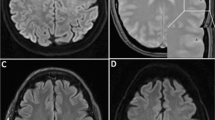Abstract
We report the case of a 69 year old man who presented hemiplegia with an ascending spread suspected to be a primary form of Mills syndrome. The patient underwent MRI, which showed multiple lacunar infarcts of the periventricular and subcortical white matter. We recommend that patients with a suspected primary form of Mills syndrome should be studied with MRI.
Sommario
Abbiamo descritto il caso di un uomo dell'età di 69 anni che presentava una forma di emiplegia ascendente, diagnosticata come una forma primitiva di sindrome di Mills. Il paziente è stato sottoposto all'esame di Risonanza Magnetica Nucleare che ha dimostrato la presenza di infarti multipli lacunari della sostanza bianca periventricolare e sottocorticale. Si consiglia pertanto di sottoporre ogni paziente con sospetta forma primitiva di sindrome di Mills all'esame di Risonanza Magnetica Nucleare
Similar content being viewed by others
References
Aboulker J.:Les myélopathies cervicales d'origine rachidienne. Neuro-chirurgie 11:87–198, 1965.
Beal M., Richardson E.P.:Primary lateral sclerosis: a case report. Arch. Neurol. 38:630, 1981.
Confavreux C., Aimard G., Devic M.:Course and prognosis of multiple sclerosis assesed by the computerized data processing of 349 patients. Brain 103:281–300, 1980.
Cossa P. Lombard P., Martin P.:Sur deux cas de syndrome pyramidal lentement progressif et secondairement bilatéralisé. Syndrome de Mills? Rev. Neurol. 84:327–330, 1951.
Decourt J.:Un cas d'hémiplegié spinale ascendante chronique. Rev. Neurol. 2:557–560, 1930.
Guillain G., Mollaret P.:Syndrome de Klippel-Feil, avec quadriplégie spasmodique, variété étiologique particulière de l'hémiplegie spinale ascendante chronique. Rev. Neurol. 1:436–444 1931.
Lhermitte J., Albessar:L'hémiplégie ascendante progressive à l'évolution prolongée. Gaz. Hop. (Paris) 11:185–190, 1934.
Mills C.K.:A case of unilateral progressive ascending paralysis, probably representing a new form of degenerative disease. J. Nerv Ment. Dis. 27:195–200, 1900.
Mills C.K., Spiller W.G.:A case of progressively developing hemiplegia, later becoming triplegia, resulting from primary degeneration of the pyramidal tract. J. Nerv. Ment. Dis. 30:385–397, 1903.
Author information
Authors and Affiliations
Rights and permissions
About this article
Cite this article
Dalla, V.G., Magoni, M., Vangi, D. et al. Role of MRI in the diagnosis of Mills syndrome. Ital J Neuro Sci 10, 519–521 (1989). https://doi.org/10.1007/BF02333948
Issue Date:
DOI: https://doi.org/10.1007/BF02333948




